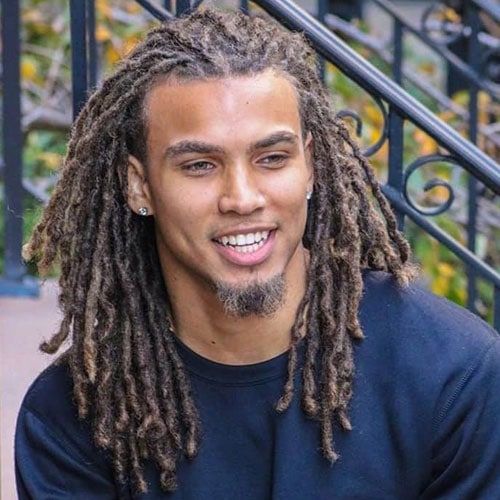
Dreadlocks are a classic and adaptable hairstyle that can be implemented on a wide range of hair textures. The selection of the most suitable hair for dreadlocks is predominantly determined by individual inclinations, texture, and length. In this guide, we’ll explore different hair types and provide insights into what works best for achieving and maintaining beautiful, healthy dreadlocks.
The Best Hair for Dreadlocks
Straight Hair
Stunning dreadlocks can be created with straight hair, although the procedure may take slightly longer than with other hair types. To promote natural sealing, gradually permit the hair to become matted and tangled. Consistent upkeep and perseverance are essential in the pursuit of attaining mature and precisely defined dreadlocks with straight hair.
Curly Hair
Curly hair is often praised for its natural tendency to lock, making the dreadlocking process more manageable. The curls create texture and hold, aiding in the formation of distinct, well-defined dreadlocks. Individuals with curly hair can enjoy a quicker and more organic journey toward their desired dreadlock style.
Coily or Afro-Textured Hair
Dreadlocks complement coily and afro-textured hair types exceptionally well. Tight coils and curls interlock naturally to create a solid foundation for dreadlocks that are robust and well-formed. The locking process for this particular hair type frequently necessitates less effort, which can yield an aesthetically pleasing, full, and textured dreadlock style.
Fine Hair
Although fine hair may present a challenge in attaining dense, resilient locks, it is still possible to accomplish this with the appropriate maintenance and care. Consisting of lengthier hair at the outset can serve to offset the diminished thickness, while consistent upkeep, including palm rolling or interlocking, can augment the aesthetic appeal of more refined dreadlocks.
Thick Hair
Thick hair serves as an ideal foundation for dreadlocks due to its substantial and voluminous appearance. The density of this hair may necessitate an extended securing period; nevertheless, the result is frequently remarkable. Consistent maintenance is imperative in order to avert the development of conjoined or excessively weighty dreadlocks.
Chemically Treated Hair
Dreadlocks can also be created from chemically treated hair, including relaxed or permed hair. It is essential to note, however, that these procedures may cause the hair to become weakened, necessitating additional care and attention throughout the transition. Throughout the process, gradual methods, such as the freeform technique, can aid in maintaining healthy hair.
Frequently Asked Questions About The Best Hair for Dreadlocks
How long does it take for dreadlocks to form?
The time it takes for dreads to form varies depending on factors like hair type, length, and chosen method. On average, it can take several months to a year for noticeable progress, but the complete maturation process may take longer.
Can I wash my hair with dreadlocks?
Yes, regular washing is crucial for maintaining healthy locks. Use residue-free shampoos and be sure to dry your hair thoroughly afterward to prevent mildew or odors.
Do I need to cut my hair to get dreadlocks?
No, cutting your hair is not necessary. You can start the locking process with hair of any length. Longer hair may take longer to show noticeable progress, but the overall process remains the same.
How can I speed up the dreadlocking process?
The process of forming dreadlocks is natural and gradual. While there’s no guaranteed way to speed it up, keeping your hair clean, avoiding excessive manipulation, and incorporating specific methods like “twist and rip” may encourage faster progress.
Can I color or dye my hair with dreadlocks?
Yes, you can color or dye your hair with dreadlocks. However, it’s generally recommended to wait until the dreadlocks are fully formed to avoid potential damage. Be sure to use products suitable for dreads and follow proper aftercare.
How often should I retwist my dreadlocks?
The frequency of retwisting depends on personal preference and the method used. Some people retwist every few weeks, while others may wait longer. Over-retwisting can lead to breakage, so find a balance that works for your hair type.
Can I start dreadlocks on my own, or do I need a professional?
While many people successfully start and maintain their locks at home, consulting with a professional stylist who specializes in dreadlocks can provide valuable guidance, especially if you’re new to the process.
How do I prevent my dreadlocks from unraveling?
Regular maintenance, including palm rolling, interlocking, or using natural products to encourage locking, can help prevent unraveling. Patience is also crucial as the locking process naturally takes time.
Can I undo or remove my dreadlocks?
While it’s possible to remove dreads, the process can be time-consuming and may cause some hair loss. Consider this decision carefully, and consult with a stylist for guidance if you’re thinking about removing your dreadlocks.
Wrap Up
Selecting the most suitable hair for dreadlocks is contingent upon personal inclinations, way of life, and intended results. Regardless of the texture of your hair—straight, curly, coily, fine, thick, or chemically treated—you can accomplish beautiful dreadlocks that reflect your individual style with the proper maintenance and perseverance. Appreciate the variety of hair textures, embrace the process, and take pleasure in the autonomy and self-expression that dreadlocks bestow upon your individual fashion sense.

Leave a Reply